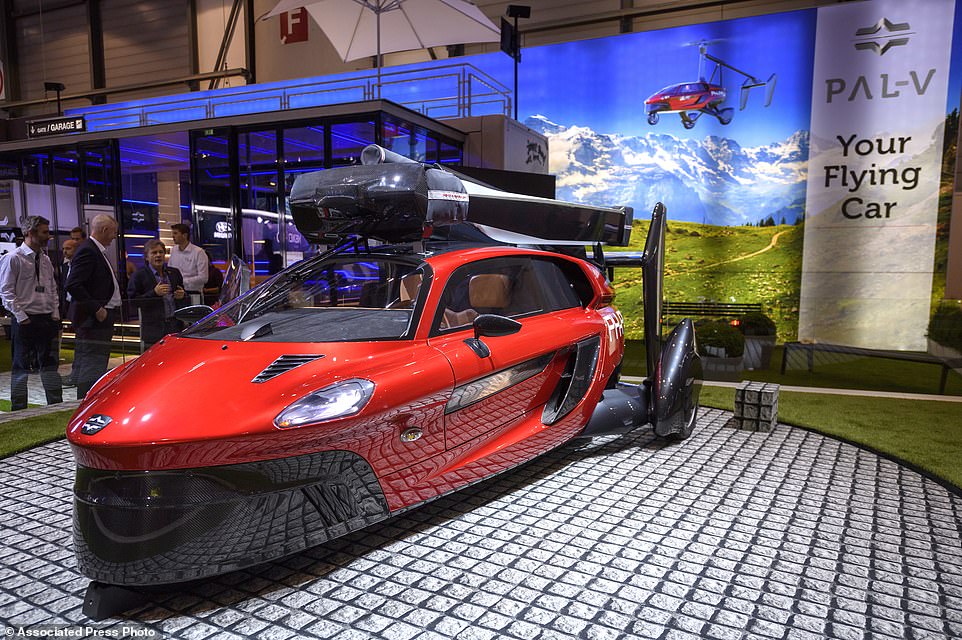A production version of the world’s first ‘real’ flying car has been unveiled at a motor show in Geneva.
The £440,000 ($600,000) Personal Air and Land Vehicle (Pal-V) Liberty can hit 112mph (180kph) on the roads and in the sky, according to Dutch firm Pal-V International.
The twin-engine craft, which looks like a hybrid between a motorbike and a helicopter, was displayed by the company ahead of the shipping of its initial batch of pre-orders in 2019.
The vehicle, revealed at the Geneva Motor Show in Switzerland on Tuesday, is a three-wheeled flying craft that can carry two people and is officially certified for use on the roads and in the skies in both Europe and the US.
It is made of carbon fibre, titanium, and aluminium and weighs 1,500lbs (680 kg), and requires a 540ft (165 metre) runway for take-off and just 100 feet (30 metres) for landing.
The craft is fitted with a similar handling system to that of a motorbike, which relies on the driver tilting the vehicle with a control stick both on the ground and in the air.
After six years of testing, PAL-V International aims to pip its competitors to the post by becoming the world’s first mass manufacturer of a flying car.
Final assembly on the £437,000 ($600,000) Pal-V Liberty began in October and the firm, based in Raamsdonksveer in the Netherlands, is aiming to deliver its first flying car to its first customer next year.
‘Flying cars have been in movies many, many times and they will be available next year,’ CEO Robert Dingemanse told The Associated Press.



In 2019, the company expects to produce between 50 and 100 of the vehicles, before ramping up to ‘quite a few hundred’ in 2020.
A slightly cheaper version to be made next – the Pal-V Liberty Sport – has a price tag of £262,000 ($335,000).
The firm has designed the car so at the flick of a button the blades fold down and gather like a bat’s wings on the top.
It incorporates a 2005 breakthrough, when Dutch company Carver invented a tilting system for three-wheelers, to counter Pal-V’s high centre of gravity and make it roadworthy.
In 2019, the company expects to produce between 50 and 100 of the vehicles, before ramping up to ‘quite a few hundred’ in 2020.
A slightly cheaper version to be made next – the Pal-V Liberty Sport – has a price tag of £262,000 ($335,000).
The firm has designed the car so at the flick of a button the blades fold down and gather like a bat’s wings on the top.
It incorporates a 2005 breakthrough, when Dutch company Carver invented a tilting system for three-wheelers, to counter Pal-V’s high centre of gravity and make it roadworthy.

The company insists the Pal-V is not a helicopter, where blades are powered by an engine, but is a gyroplane in which the blades rotate thanks to airflow.
Even if both engines cut out, the blades will still turn.
‘The rotor is not powered, so it’s actually a parachute which is always available,’ Mr Dingemanse told AP.
Different versions of a flying car are being developed in the Czech Republic, Slovakia, Japan, China and the United States.
The lucky owner will need both a driving licence and a pilot’s licence.


But with the keys in hand, the owner will be able to drive to an airfield for the short take-off and, after landing elsewhere, drive to the destination in a door-to-door experience.
Parts are on order, with the first already in stock.
Once built, the vehicle will have to complete at least 150 flying hours, and undergo extensive tests to receive its certification from the Cologne-based European Aviation Safety Agency (EASA).
Once finalised this will allow them to certify under FAR 27 regulations in America.

The Pal-V uses normal unleaded petrol for its two 100-horsepower engines.
The 27-gallon gas tank provides a flying range of between 248 an 310 miles (400 to 500 kilometres) at an altitude of up to 11,500 feet (3,500 metres).
On the road, it can drive for up to 750 miles (1,200km).
The helicycle has a top speed of around 105 mph (170 km/h) and goes from 0 to 60 mph (0 to 95 km/h) in under eight seconds.
Speaking to AFP last year, chief marketing officer Markus Hess said: ‘This kind of dream has been around for 100 years now.
‘When the first airplane was invented people already thought ‘How can I make that driveable on the road?’













